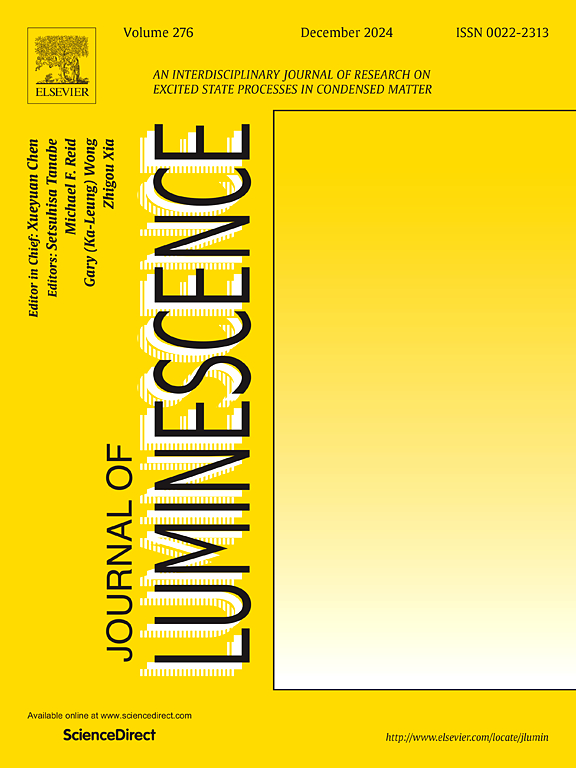基于Li2CaTa2O7:Ln3+荧光粉(Ln3+ = Pr3+, Er3+)不同发光热响应的光学温度计设计策略
IF 3.3
3区 物理与天体物理
Q2 OPTICS
引用次数: 0
摘要
本文研究了Li2CaTa2O7:Ln3+ (Ln3+ = Pr3+, Er3+)荧光粉的光致发光性能。在450nm蓝光激发下,Li2CaTa2O7:Pr3+表现出从绿色到红色的发射范围,其对蓝光激发的强烈响应使其更容易集成到器件封装过程中。在379 nm激发下,Li2CaTa2O7:Er3+的发射光谱在绿色和近红外区域均显示出特征峰。随着温度的升高,533 nm (Pr3+)和528 nm (Er3+)发射峰的光致发光强度略有增强。基于Pr3+和Er3+热耦合水平的不同温度依赖性,采用荧光强度比(FIR)法计算样品的相对灵敏度(Sr)和绝对灵敏度(Sa)。在Li2CaTa2O7基质中,Pr3+和Er3+在120 K和140 K时的最大Sr值分别为3.072%和7.739% K−1。这些结果证明了Li2CaTa2O7:Ln3+ (Ln3+ = Pr3+, Er3+)优异的测温性能,突出了其在温度传感应用中的潜力。本文章由计算机程序翻译,如有差异,请以英文原文为准。
Design strategies for optical thermometers based on diverse luminescence thermal-response in Li2CaTa2O7:Ln3+ phosphors (Ln3+ = Pr3+, Er3+)
In this paper, the photoluminescence properties of Li2CaTa2O7:Ln3+ (Ln3+ = Pr3+, Er3+) phosphors were investigated. Under the 450 nm blue light excitation, Li2CaTa2O7:Pr3+ exhibits emission ranging from green to red, and its strong response to blue-light excitation facilitates easier integration into device encapsulation processes. Under 379 nm excitation, the emission spectra of Li2CaTa2O7:Er3+ display characteristic peaks in both the green and near-infrared regions. As the temperature increases, the photoluminescence intensities of the emission peaks at 533 nm (Pr3+) and 528 nm (Er3+) show a slight enhancement. Based on the distinct temperature dependencies of the thermally coupled levels of Pr3+ and Er3+, the relative sensitivity (Sr) and absolute sensitivity (Sa) of the samples were calculated using the fluorescence intensity ratio (FIR) method. The maximum Sr values for Pr3+ and Er3+ in the Li2CaTa2O7 host were found to be 3.072 % K−1 at 120 K and 7.739 % K−1 at 140 K, respectively. These results demonstrate the excellent thermometric performance of Li2CaTa2O7:Ln3+ (Ln3+ = Pr3+, Er3+), highlighting its potential for temperature sensing applications.
求助全文
通过发布文献求助,成功后即可免费获取论文全文。
去求助
来源期刊

Journal of Luminescence
物理-光学
CiteScore
6.70
自引率
13.90%
发文量
850
审稿时长
3.8 months
期刊介绍:
The purpose of the Journal of Luminescence is to provide a means of communication between scientists in different disciplines who share a common interest in the electronic excited states of molecular, ionic and covalent systems, whether crystalline, amorphous, or liquid.
We invite original papers and reviews on such subjects as: exciton and polariton dynamics, dynamics of localized excited states, energy and charge transport in ordered and disordered systems, radiative and non-radiative recombination, relaxation processes, vibronic interactions in electronic excited states, photochemistry in condensed systems, excited state resonance, double resonance, spin dynamics, selective excitation spectroscopy, hole burning, coherent processes in excited states, (e.g. coherent optical transients, photon echoes, transient gratings), multiphoton processes, optical bistability, photochromism, and new techniques for the study of excited states. This list is not intended to be exhaustive. Papers in the traditional areas of optical spectroscopy (absorption, MCD, luminescence, Raman scattering) are welcome. Papers on applications (phosphors, scintillators, electro- and cathodo-luminescence, radiography, bioimaging, solar energy, energy conversion, etc.) are also welcome if they present results of scientific, rather than only technological interest. However, papers containing purely theoretical results, not related to phenomena in the excited states, as well as papers using luminescence spectroscopy to perform routine analytical chemistry or biochemistry procedures, are outside the scope of the journal. Some exceptions will be possible at the discretion of the editors.
 求助内容:
求助内容: 应助结果提醒方式:
应助结果提醒方式:


